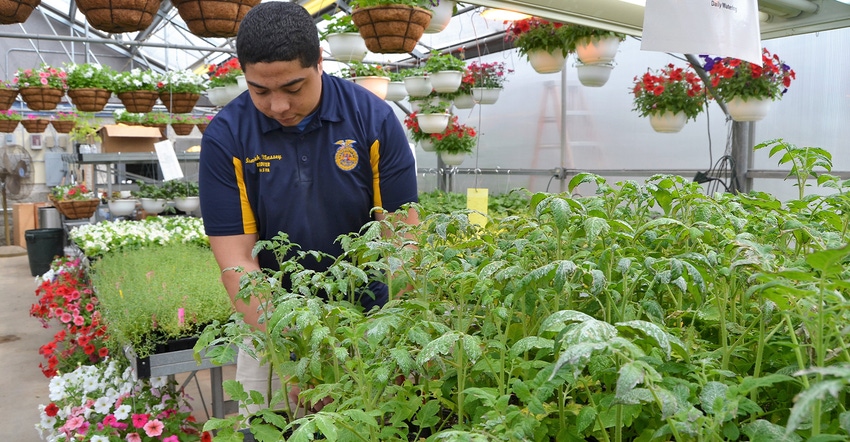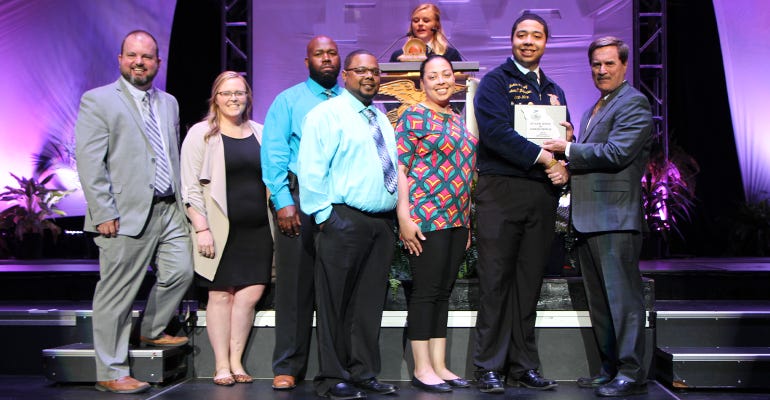
Isaiah Massey spent most of his junior high school days playing in the band or suiting up as a lineman on the football field. It all changed when classmate Sarah O’Hare walked up behind him in the hall and said, “You should join FFA.”
There he was, sporting Jordan sneakers and gym shorts. “I thought she was talking to someone else,” Massey says. But she wasn’t. So, the young man who lived in a subdivision signed up for an agricultural education class at Troy Buchanan High School and became involved in FFA.
Without a background in production agriculture, Massey took a nontraditional approach to his Supervised Agriculture Experience Program in agriscience research. Over four years, he developed three projects, which paid off in April as Massey was named Star in Agriscience during the Missouri State FFA Convention.
The research
Massey began his SAE researching how his fellow freshman students retained knowledge about the agriculture industry. People took a pre-quiz to determine how much they knew about the industry, then they were divided into groups and provided education on hot topics in agriculture.
Some learned through social media, websites, YouTube and printed material. Massey then administered a post-test. He found teaching through YouTube improved participants’ responses by an average of 34%. His study showed the most effective education method was visual learning. The least effective was printed materials.
As a sophomore, Massey researched the influence advertisers have on consumer perception. He found out just because an ad or article has more numbers does not mean people perceive it as true. Many responded to color and pictures. “If they can connect with the picture,” he says, “they are more apt to believe it is true.”
By his junior year, Massey was enrolled in AP environmental science. The class was discussing the effect of greenhouse gas on the world. The topic piqued his interest.
“I thought about how all of this relates to agriculture and wondered just what we can do to reduce our carbon footprint,” he says. After searching, he found biochar, a charcoal used as a soil amendment.

TOP HONORS: Missouri FFA Star in Agriscience Isaiah Massey (second from right) shakes hands with MFA chief financial officer Jeff Raetz at the Missouri FFA Convention in April. He is surrounded by family and FFA advisors, including (from left to right) Troy FFA advisors Matt McCrory and Elizabeth Utterback, and family members Antywan Mayfield, Duane Massey and Samantha Scholtz.

Massey looked at university studies stating biochar reduces carbon dioxide and nitrous oxide emissions, considered a greenhouse gas, by up to 80%. He focused on a Yale study claiming biochar applied to 10% of the cropland acres would reduce their carbon footprint by 75%. Then, he set out to test it on a smaller scale in the high school greenhouses.
He used Black Gold biochar on tomatoes, bell peppers, marigolds and dusty millers. He planted species into soil with biochar, another group into a premix and another to traditional garden soil, nothing added.
Working with University of Missouri Extension agriculture engineering specialist Charles Ellis, he learned growers use different water types — fertilized and nonfertilized. So, Massey also separated the groups into two water categories.
He tested the carbon emissions of each plant type, looking at parts per million. Using dimensional analysis learned in his AP environmental science class, he assessed the data. Then he determined what the data means on a yearly basis. “The data shows that biochar realizes 200,000 ppm less than other two remedies this year,” he says.
Science of ag education
Troy FFA agriculture educator Matt McCrory encourages his students to participate in agriscience research. “It is one FFA program that builds kids in so many different areas,” he explains. “It makes them use scientific research methods, develops their critical thinking and problem-solving and also improves their oral communications skills.” McCrory points out that after completing the project, members must give a 15-minute oral presentation.
He encourages his members to seek specialists in their field for advice. Members in Agriscience SAE interact with university scientists, business professionals and industry leaders.
“These are experiences most students in high school don’t have,” McCrory adds, “but we are fortunate that agriculture steps up and helps these students, preparing them for the future of our industry.”
McCrory finds agriscience is one more avenue that brings STEM — science, technology, engineering and math — into agriculture education. “Agriscience is not easy,” he says, “but kids are digging deep into topics and finding answers.”
Still, there is one side of this project many do not see — personal growth. With each year, McCrory saw Massey become more confident, not just in the science or the communication, but as a person. “It carried over into our FFA chapter,” he says. “Isaiah is a leader.”
Advancing education
Massey graduated from Troy Buchanan High School and will attend Northwest Missouri State University majoring in agriculture education and minoring in agriculture communications. He would like to work in public relations helping others understand the science behind agriculture.
He will have that chance to spread the word sooner as Massey was named Missouri FFA first vice president for 2019-20. This year, he will travel the state sharing his story with fellow FFA members, industry leaders and government officials.
Massey says he will encourage others to dive deeper into agriculture issues and never be afraid to invite fellow high school students to join the FFA.
“It takes one person, like Sarah, to ask,” he says. “You never know what you will learn or where it will lead.”
About the Author(s)
You May Also Like






